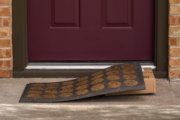Poorly draining soil and low ground can easily leave standing water in your yard. Not only can this be a nuisance, but it can also be a threat to your property. Stagnant water can result in lawn, tree, basement and foundation damage, which can hurt your home’s value and lead to costly repairs down the road.
French drains are a cost-effective option to help protect your property from standing water and reduce the chance of flooding. Plus, it could show prospective buyers that you’ve invested in the proper maintenance to protect your property.
— What is a French drain?
— The pros and cons of a French drain.
— How does a French drain work?
— How are French drains installed?
— How much do they cost to install?
— Does a French drain impact the resale value of a home?
— DIY vs. hiring a pro.
[Read: The Guide to Home Renovations.]
What Is a French Drain?
If flooding in your basement or yard is a common problem, then a French drain system may be your solution. French drains are a system of ditches and pipes that are used to divert water away from a specific area, like a home’s foundation.
“French drains are used to prevent flooding in yards and basements by diverting water away from your home and yard instead of letting it pool in your yard or seep back into your basement,” explains Bailey Carson, home care expert at Angi, the home improvement network and information company.
The Pros and Cons of a French Drain
Pros
— French drains help prevent flooding and reduce the risk of long-term water damage to your property.
— They can last between 30 and 40 years.
— They’re cost-effective.
— French drains can be aesthetically pleasing as they are usually covered with small rocks, plants and sometimes even decorative grates.
Cons
— The installation process can be long and frustrating.
— Existing structures, such as a deck or walkway, may need to be removed when digging trenches.
— It could be dangerous to dig in areas with water, power or communications lines buried in the vicinity.
— French drains can sometimes become clogged and overflow, causing damage.
How Does a French Drain Work?
To move water away from one area to another, a French drain system consists of a ditch lined with gravel and a perforated pipe that drains the water. “This water is diverted by gravity to the appropriate place, usually a drainage ditch, sump pump, storm drain or sewage system,” Carson says.
The French drain provides an easy path for water to flow through the gravel and into the drainage pipe. The perforated pipe should also be at a downward-sloping angle to allow gravity to do its job.
A weeping tile or interior French drain can also be used to prevent basement flooding and protect the property’s foundation from water damage. A weeping tile is a type of French drain and is used to protect a structure against hydrostatic pressure. They’re placed around the perimeter of the home to draw water away from the foundation.
[See: 10 Home Renovations Under $5,000.]
How Are French Drains Installed?
Because installing a French drain is such a large project, sometimes requiring permits, contacting a professional is usually recommended. “You’ll also need to call 811 before you dig to make sure you don’t accidentally interfere with any gas or utility lines underground when you make your trench,” Carson adds.
Once an area has been marked and cleared for digging, a trench is dug and lined with landscaping fabric to keep weeds and roots from clogging the pipe. “Then, they’ll place the inlet grate at the top of the trench and start installing the pipes. They’ll continue installing the pipes until they get to the drainage point,” says Carson. “After the pipes and grate are installed, they’ll test the drain to make sure everything is working properly and then they’ll cover the trench by filling it with gravel and topsoil.”
How Much Do They Cost to Install?
According to Carson, the average cost to install a French drain system is around $5,000, but the exact cost will depend on its size, type and location. Here’s what to expect, including materials, labor and permits, according to HomeAdvisor:
— Exterior perimeter drains: $10-$50 per linear foot
— Interior French drains: $40-$100 per linear foot
— Curtain drains: $10-$25 per linear foot
— Trench drains: $10-$35 per linear foot
[READ: The Best Free Interior Design Apps.]
Does a French Drain Impact the Resale Value of a Home?
“Water damage can be detrimental to a home’s value and can lead to expensive repairs down the road,” says Carson. “If you’re experiencing water damage on your property, the best thing you can do is figure out the root cause of the issue and fix it to prevent any further damage.”
On average, it costs between $2,000 and $7,000 for remediation and cleanup of a 500- to 800-square-foot basement with 2 feet of water, according to home improvement information site Fixr. Foundation repairs can cost the same or even more, depending on the extent of the damage. You could spend up to $30,700 to install piers, fix cracks and install a French drain.
“A French drain is a worthwhile investment if it will help protect your home and yard. If installed correctly, it shows prospective buyers that you took care of your home and were willing to invest in the right projects to maintain it,” Carson adds.
DIY vs. Hiring a Pro
It’s possible to DIY French drain installation, but this depends on the size of your yard and the scale of your drainage problems. But if you run into buried utility, sewer or drain lines, you may want to call a professional French drain installer.
Cutting lines or incorrect installation can cost thousands of dollars in potential repairs and replacement fees. Some states even require homeowners to call 811, the “Call Before You Dig” line, at least two to three days before digging so underground utility lines can be located and marked safely. Consider checking your neighborhood’s zoning restrictions and ask your local building department about necessary permissions.
To DIY French drain installation, you’ll need to physically be able to dig a trench, or you could rent a trencher from a local home improvement store. You’ll also need the right equipment, such as flexible drainage pipes, landscaping fabric, gravel and an inlet grate. This can be difficult work, so you may need the help of family or friends to get the job done. Make sure the trench is at least 18 inches deep and nine to 12 inches wide. French drains also need a slope of at least one inch for every 10 inches of pipe, or it won’t work.
When in doubt, call a professional French drain installation company.
More from U.S. News
The Best Real Estate Apps to Download
10 Helpful House Hunting Apps for 2023
10 Ways Millennials Are Changing Homebuying
French Drains: How Much They Cost and How They Work originally appeared on usnews.com
Update 04/25/23: This story was previously published at an earlier date and has been updated with new information.







